Lexus IS (2013-2020) Review
Written by Andrew Brady
Quick overview
Pros
- Bold styling
- Excellent standard safety equipment
- Incredible stereo in the range-topping model (or optionally)
Cons
- Hybrid no longer a unique selling point in this class, and plug-in rivals do it better, too
- Hopelessly fiddly controller for the infotainment
- Drivetrain and the dynamics lack the sparkle and driver appeal of its polished, newer rivals
Overall verdict on the Lexus IS
"In this Lexus IS review we're looking back at compact premium saloon contender that was largely forgotten even when it was on sale, so the fact that it disappeared from the UK market in 2020 hasn't done much for its legacy. Loved by those who bought one but ignored by those who chose more popular German, Italian or British offerings, the Lexus IS arguably makes more sense as a solid used purchase if you don't want to follow the herd."
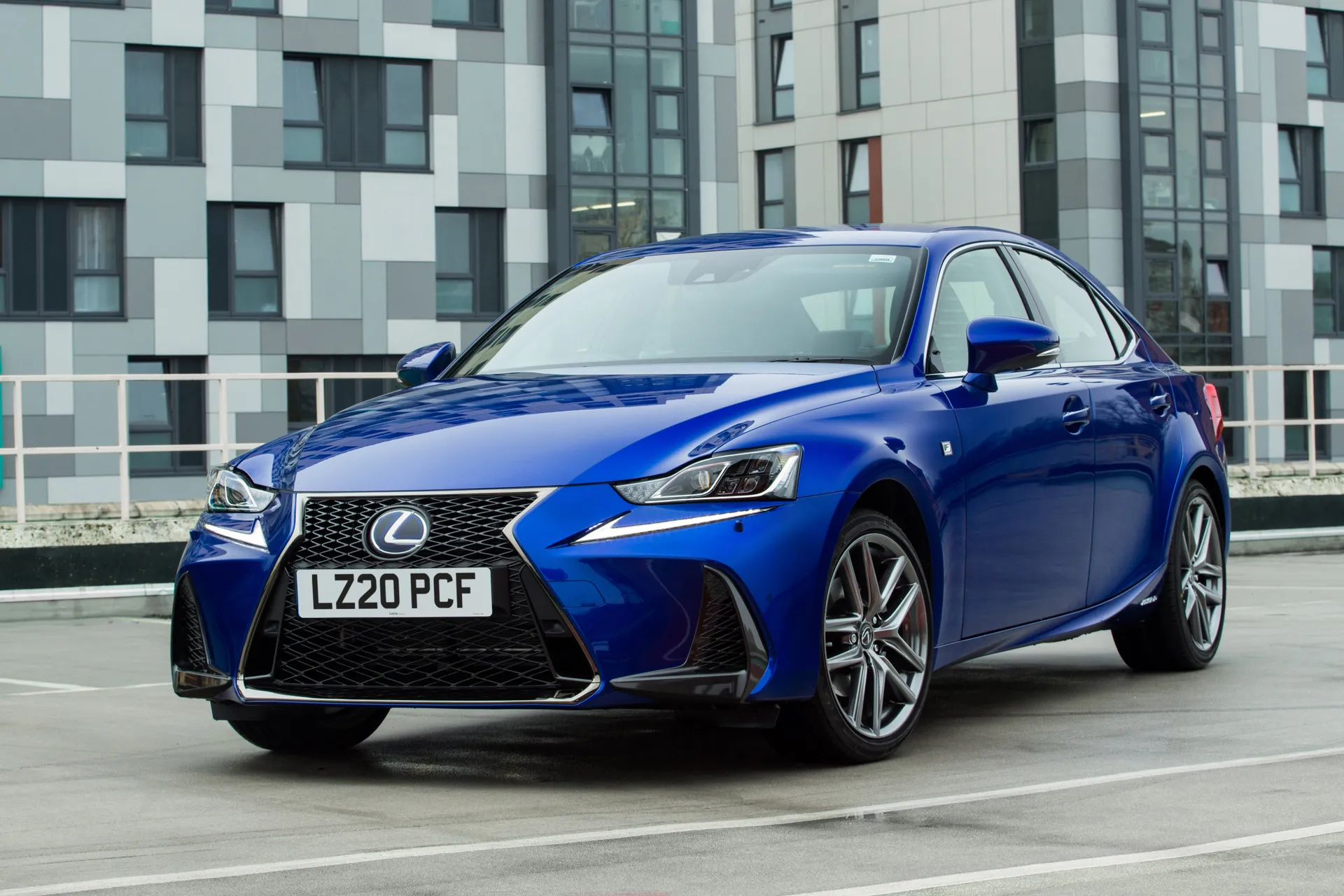
The Lexus IS has been around since 1999 as Japan’s take on the premium mid-sized executive sports saloon, an alternative to the all-too-obvious Audi A4, BMW 3 Series and Mercedes-Benz C-Class. To that, you can add the Jaguar XE and the Alfa Romeo Giulia, and a host of other mainstream saloons with upmarket aspirations.
The Lexus IS has always been the car that’s been mentioned in passing, rather than a serious buying proposition among its such competition, its appeal stymied not just by its quirkiness, but also its advancing years.
The current IS was introduced way back in 2013 and was revised for the 2017 model year before being discontinued in 2020. Tellingly it's replacement hasn't been offered in the UK or European marketplaces, instead Lexus focussing its efforts with the IS on countries where its sales have traditionally been stronger, those being the US and its Japanese home markets.
That’s despite the IS regularly winning awards for customer satisfaction in the UK, those few buyers who do buy the IS are seemingly delighted with it, and evidently only too happy too to tell people about how good it is. Lexus dealers have an impeccable reputation for customer service, while reliability is also a given with the brand, too.
The Lexus IS has always dared to be different, not just in relation to its bold styling and quirky interior, but also its powertrains. The engine line-up has changed over its lengthy production run, but not much, with a V6 2.5-litre petrol in the Lexus IS250 and a self-charging hybrid IS300h topping the model line-up. A 2.0-litre turbocharged petrol was briefly offered, but for a few years now the only engine choice has been that sole hybrid IS300h.
That means no diesels, which might look like an inspired decision in the current anti-diesel marketplace, but over the course of the Lexus IS’s life it’s meant it’s been discounted from most buyers’ lists, even if that hybrid could match and better its diesel rivals for CO2 emissions – and hence minimise company car tax liability.
That it’s not being replaced isn’t really a surprise, with compact SUV sales decimating the traditional compact saloon marketplace, as well as fierce competition from better established rivals in both the premium and mainstream sectors, it’s a tough car to recommend. With many rivals also offering excellent plug-in hybrids that better the older self-charging tech, Lexus has sensibly called time on its IS model here and we’re not sure anybody is really going to miss it.
Looking for a used car for sale? We've got 100s of Lexus Approved Used Cars for Sale for you to choose from, including a wide range of Lexus IS cars for sale. If you're looking for the different version, you can check out our Lexus GS review.
Is the Lexus IS right for you?
When the original IS200 was launched back in 1999 it took a bold shot at more sporting saloons in the premium segment, delivering a drive that was a convincing alternative to the BMW 3 Series. Evidently, that ambition has diluted with time, with the most recent Lexus IS seemingly revelling in being a leftfield choice rather than one that can genuinely be mentioned against its more sporting rivals.
On the plus side, Lexus has its excellent dealer service in its favour, while the IS300h does emit commendably low CO2 and feels different inside and looks it outside. It’s pretty refined, too.
What’s the best Lexus IS model/engine to choose?
Two petrol engines were offered during the Lexus IS's lifespan: a 2.0-litre turbocharged unit in the Lexus IS200t with 248PS and a 2.5-litre in the IS250 with 207PS, but sales of these versions were miniscule in comparison to the hybrid IS300h, which provides a total power output of 223PS. The hybrid also uses a CVT gearbox, while the petrol versions come with a conventional automatic only.
Trims are a little bit more expansive in their offerings, with the Lexus IS offered in three grades, these being Lexus IS, F-Sport and Takumi. Even though it’s the priciest, that Takumi is the one we’d suggest, because it’s fully loaded with equipment as standard, including a reversing camera, blind spot monitoring and the exceptional Mark Levinson premium surround sound 15-speaker audio system, which, if you like your music, is almost reason enough alone to buy an Lexus IS. Just make sure you negotiate a hefty discount.
What other cars are similar to the Lexus IS?
We’ve already mentioned a few, the Lexus IS traditionally a car that’s been touted as a rival for cars like the BMW 3 Series, Audi A4 and Mercedes-Benz C-Class, as well as a huge number of mainstream and upper mainstream saloons.
As time’s passed the Lexus IS’s hybrid unique selling point has been eroded significantly, with most rivals now able to offer not just similar mild, self-charging hybrids as alternatives, but far superior plug-in competitors that offer genuine commuting range electric-only range and performance – both environmentally and against the stopwatch.
Comfort and design: Lexus IS interior
"With its interior instrumentation referencing Lexus’ LFA supercar and a design that’s daringly different to the all-too-similar Germanic norm, the Lexus IS’s cabin is a pleasing diversion in the class it competes in."
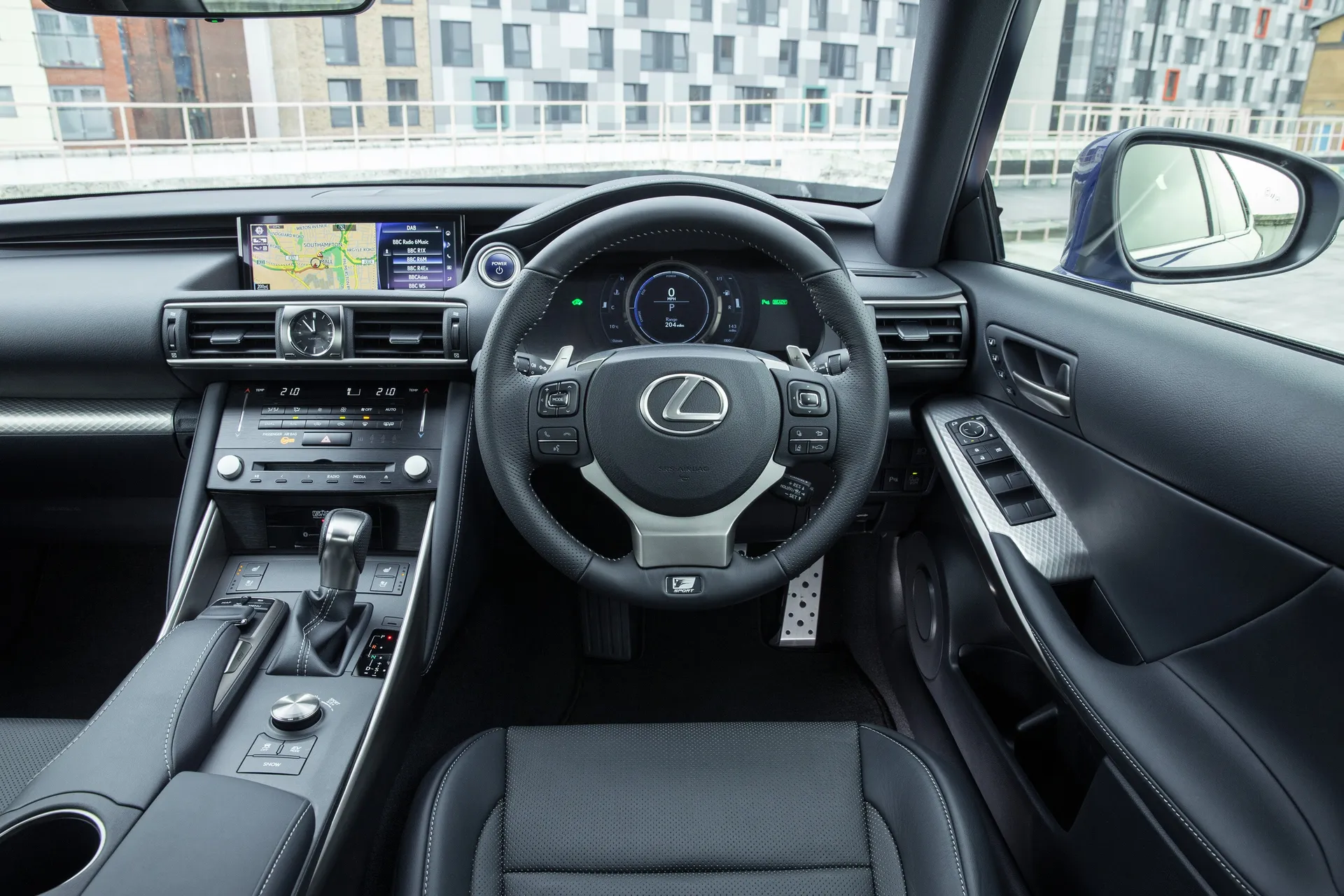
There’s a substantial centre console running between the driver and passenger, with large soft knee-pads either side of it from 2017, substantial enough that Lexus referenced them repeatedly as one of the features of the revised Lexus IS. That sizeable centre console doesn’t impact on the feeling of space up front, with plenty of room for even taller occupants to stretch out.
All come with dual-zone climate control as standard, so each front seat can select their desired temperature – via the somewhat fiddly sliding touch button either side of that centre console.
Heated seats are standard on the Lexus IS, with the F-Sport these being part of an option pack, with Takumi trim’s front seats being both heated and ventilated as standard. There’s electric adjustment for the driver’s seat on all, with six-way control on the Lexus IS, upped to eight-way on the F Sport and Takumi.
There’s a manually adjustable steering column on the Lexus IS and F Sport, with Takumi gaining electric adjustment, all have front and rear parking sensors, a push button start and interior LED lighting, with the entry-level Lexus IS getting the option of the Comfort Pack, which adds Tahara fabric upholstery, a rear-view camera, smart entry, rain-sensing wipers and an auto-dimming rear-view mirror.
Quality and finish
Lexus is famed for its reliability and the interior exhibits the company’s incredible attention to detail and build quality. It’s undeniably busier inside visually, the Japanese take on car interiors more differing to the slightly more restrained style of European premium alternatives, but you can’t deny the pervading feel of solidity inside.
There are some really nice finishes inside, with a choice of metals and even laser cut wood trims – which Lexus sources from Yamaha’s musical instrument building division. Only the Takumi has leather upholstery as standard, the others requiring some option box ticking for leather, which is regrettable, with most rivals able to offer leather, or at least convincing fake leather at the Lexus IS’s price point.
Infotainment: Touchscreen, USB, nav and stereo in the Lexus IS
The march of progress is no better demonstrated by the Lexus IS’s infotainment system. As standard, it comes with a 7.0-inch Lexus Media Display with 6-speaker audio, a CD player, DAB, full European mapping, 2 USB sockets, an aux-in socket and Bluetooth telephone connection. Compatible phones can be mirror-linked to the screen, but the Lexus IS doesn’t support Apple CarPlay or Android Auto.
All that is controlled by a remote dial control, or, if you opt for the Lexus Premium Navigation with 10-speaker audio, you get a Remote Touch Interface control and a larger 10.3-inch display. Neither control method is perfect, the Lexus IS hailing from a time when screens were still in their infancy, and, even then, it was a bit behind in its operational simplicity and slickness.
While we’re not the biggest advocates of touch screens here, they’re hugely better to use than Lexus’ Remote Touch Interface solution, it almost impossible to select things at standstill, let alone while the car is on the move. If you can get it to work, the stereo is good, though the navigation graphics do betray the system’s advanced years. We’d suffer all that for the optional (on F Sport) and standard on Takumi, Mark Levinson 5.1 channel surround sound system, which brings incredible high-end HiFi to the Lexus IS’s cabin.
Space and practicality: Lexus IS boot space
When the Lexus IS was launched Lexus was quick to point out its longer wheelbase, which in conjunction with recesses in the backs of the front seats, brought far greater legroom to the rear of the Lexus IS. The class here isn’t exactly defined by commodious rear accommodation, and while a couple of adults can get reasonably comfortable back there, if you want lounging space you’ll be better served by a Skoda Superb.
That’s true of all the Lexus IS’s rivals, though, and where it really matters, in the front seats, there’s ample room for both the driver and passenger, with decent cubby storage including a lidded bin in the centre console and sizeable door pockets up front. A pair of deep cupholders are also in the centre console, but if you do fill them with anything taller than a short coffee you might find them further hampering the control of the already fiddly infotainment system.
There are three seatbelts in the back, but really, as with all rivals, the Lexus IS is better for two in the back, not least because of the sizeable transmission tunnel that eats into foot space.
There’s a pair of ISOFIX child seat mounts for the outer rear seats, while all have a split-fold backs in a 60/40 format to load longer loads through from the boot. Being a hybrid the bootspace is slightly compromised thanks to the battery under the floor, this also necessitating the removal of a spare wheel – the IS driving on run-flat tyres – but the boot’s volume of 450 litres is respectable, and it’s a good shape, likewise the opening is relatively large for a saloon.
The Lexus IS dimensions are 4665mm long, 2027mm wide and 1430mm tall.
Handling and ride quality: What is the Lexus IS like to drive?
"The Lexus IS has the right ingredients for this class being rear-wheel drive, with the choice of drive modes that adjust the Adaptive Variable Suspension to provide sharper responses, flatter cornering and better control."
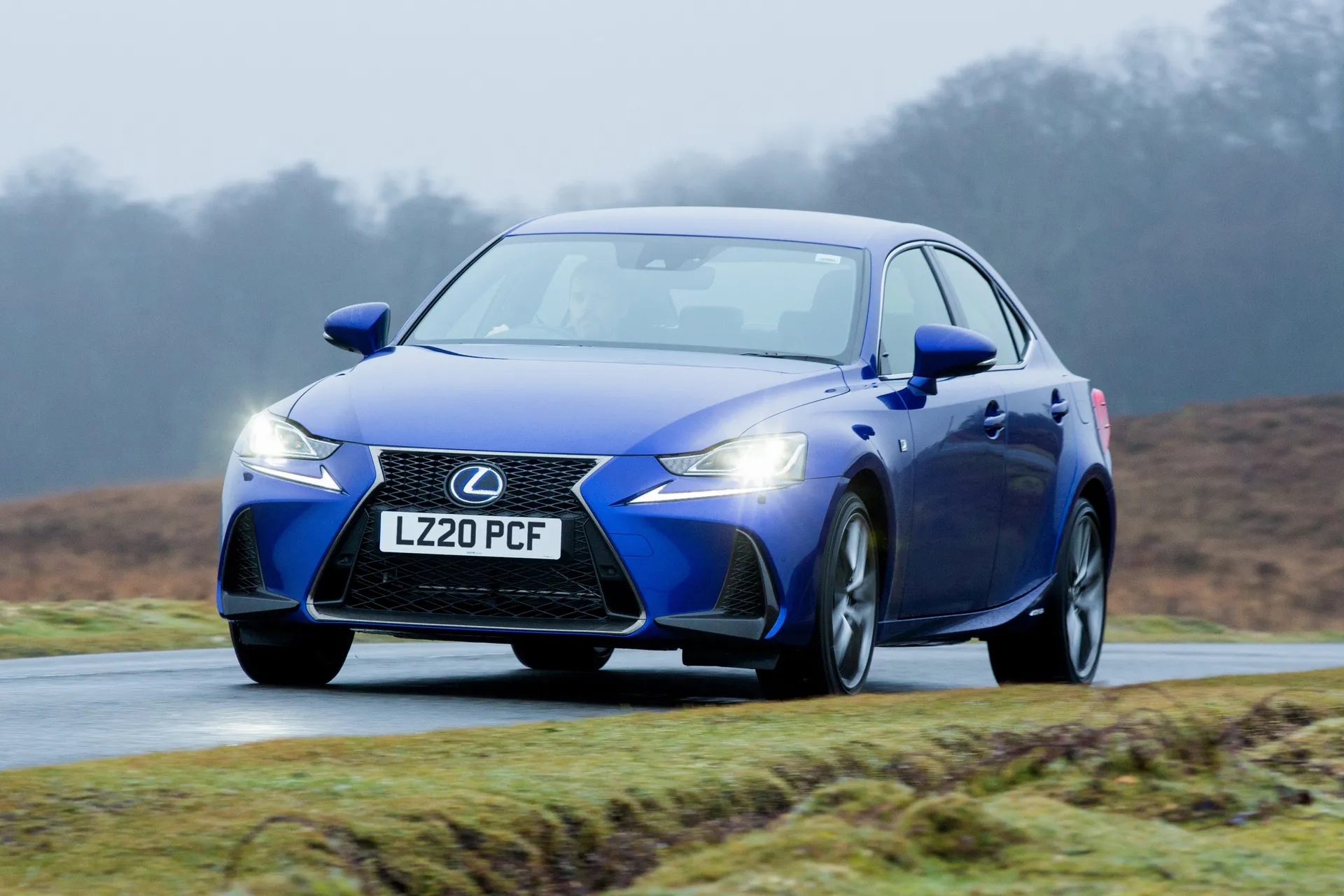
Indeed, as part of the 2017 revisions to the Lexus IS, Lexus seriously revised the suspension and steering in a bid to improve the overall dynamic responses, in a bid to address the criticism that the car before lacked driver engagement. It went as far as changing suspension assemblies from steel to aluminium, all while completely overhauling the spring and damper rates, on the double wishbone front and multi-link rear suspension.
That did improve the Lexus IS, delivering a more accomplished ride quality, while also benefitting accuracy and feedback behind the wheel. The chassis is good rather than remarkable in this respect, and even if it were exceptional it would still be working with a powertrain that’s not best suited to exploiting it.
That’s regrettable, as there’s talent, grip and control on offer, but there’ just no real incentive to try and exploit it, which in a class where fine handling, mixed with engaging, enjoyable powertrains is the norm rather than the exception, goes some way to explaining why the Lexus IS never made a huge impact against its fine-driving rivals.
What engines and gearboxes are available in the Lexus IS?
Towards the end of the Lexus IS’s lifecycle it was only offered in Lexus IS300h guise. That’s h for hybrid, though unlike so many of its electrically assisted competition now, it does without a cable for charging it. Being a ‘self-charging’ system it scavenges back power to charge its small battery when it can, via brake recuperation, or by diverting a little bit of engine power to the battery pack when it’s not needed elsewhere.
If you’ve driven a Prius (from Lexus’ parent company Toyota) you’ll be familiar with this type of hybrid. The promise is of diesel-like economy, without diesel-like emissions, that electric motor also having the benefit of allowing some infill to broaden the responsiveness of the 2.5-litre petrol engine it assists, and very occasionally, completely replaces. It works smoothly enough, the combined output being 223PS, allowing it to reach 62mph in 8.4 seconds and a top speed of 125mph.
That all drives through an E-CVT, which is a continuously variable transmission, and, arguably the Lexus IS’s most unappealing feature. There’s a huge disconnect between what you ask from the accelerator and the response you get, with the CVT particularly unruly if you ask for all the performance, while pulling away at the paddle-shifters to take over yourself via stepped ratios seems to make no difference, either.
It’s this that hampers the Lexus IS so much it feels a generation or two behind the quick-shifting accuracy, smoothness and speed of rivals’ twin-clutch automatics, at all but the most moderate speeds.
Refinement and noise levels
The cabin is comfortable, refinement, too, is impressive, Lexus having worked hard to bring premium levels of hushed quiet to the Lexus IS’s interior. A good deal of that is down to the aerodynamics, being very quiet in relation to wind noise, though all that’s ruined if you start pushing the drivetrain and the engine’s revs rise and hold thanks to that E-CVT transmission.
Take it easier, then, and the Lexus IS is dignified transport, which all gives you a better platform to enjoy the excellent listening experience of the Mark Levinson HiFi, if it has one of course. Tyre noise suppression on the road is decent, too, despite the Lexus IS having standard fitment of run-flat tyres, the short spurts of electric-only motoring the hybrid system allows underling just how hushed the Lexus IS can be.
Safety equipment: How safe is the Lexus IS?
All Lexus IS come with driver and front passenger front, side and knee airbags, while there’s a curtain airbag running the length of the cabin. ABS with Electronic Brake Force Distribution and Brake Assist, and a traction and stability control system are standard on all, too.
There’s a pop-up bonnet to help protect pedestrians in an impact, ISOFIX child seat mounts in the outer rear seats, a tyre pressure monitoring system, while Lexus also bundles a lot of safety equipment into all under its Lexus Safety System+ banner. That contains Dynamic Radar Cruise Control, Pre-Collision Assist, Lane Keep Assist, Road Sign Assist, Sway Warning System and Automatic High Beam for the headlights, on every trim level.
The range-topping model benefits from a standard reversing camera with Rear Cross Traffic Alert and a Blind Spot Monitor and back in 2013 when it was tested by Euro NCAP, it scored a full five star rating in crash testing.
Maximum EV range
In a world where you can buy plug-in hybrids that will cover your daily commute in electric-only modes, the Lexus IS300h’s hybrid system’s potential EV only range is very limited. Lexus doesn’t actually quote a figure, but it does default to EV on start up, and if you try hard you might get a couple of miles out of battery running alone.
MPG and fuel costs: How much does a Lexus IS cost to run?
"Think of the hybrid system in the Lexus IS300h as a means to generate greater fuel economy rather than a means of propelling you on your local journeys."
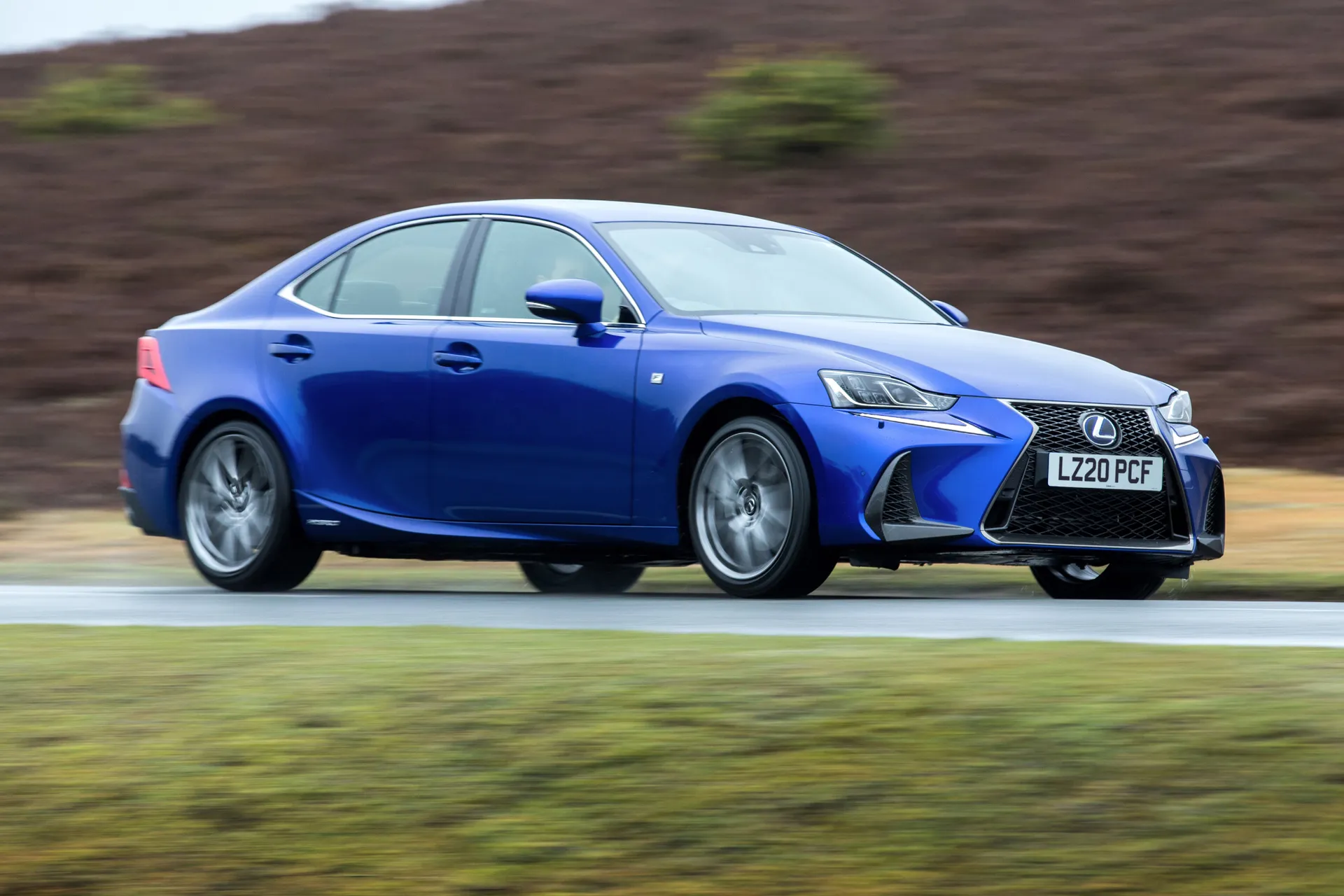
On the official WLTP test cycle, the Lexus IS300h manages between 44.8-48.7mpg, which isn’t that impressive these days. A diesel rival will easily significantly better that, while newer plug-in rivals can genuinely double that. There’s no charging time, or cost, because there’s no means of charging it, the Lexus IS300h filling its batteries on the move, or when braking.
How reliable is a Lexus IS?
The Lexus IS scored a mighty 9.71 out of 10 for reliability in the HonestJohn.co.uk Satisfaction Survey, which actually doesn't come as a surprise at all.
Lexus as a brand came second overall in the same survey, finishing just behind Dacia, so if you find a well-maintained example you can be pretty confident that your Lexus IS will be largely trouble-free.
Insurance groups and costs
The Lexus IS300h is listed in groups 28 to 38 for insurance, which is broadly similar to its rivals, so insuring the Lexus shouldn’t be any more troublesome or expensive as doing so with its more familiar competition.
VED car tax: What is the annual road tax on a Lexus IS?
Unsurprisingly the Lexus IS300h is the best performer here, and if you go for an SE model registered before the April 2017 rule changes you'll pay nothing towards VED. Even the F Sport version on bigger wheels is only £10 a year. After this date you'll pay £155 a year.
The other engine versions are more painful. A Lexus IS200t is £265 before April 2017 and £165 after, while the Lexus IS250 is £330 or £165 depending on its age.
How much should you be paying for a used Lexus IS?
"Having been around for so long there’s a sizeable choice in the used classifieds, to suit almost any budget. You can pick up a Lexus IS250 from £12,000, but the majority are about £15,000 and up."
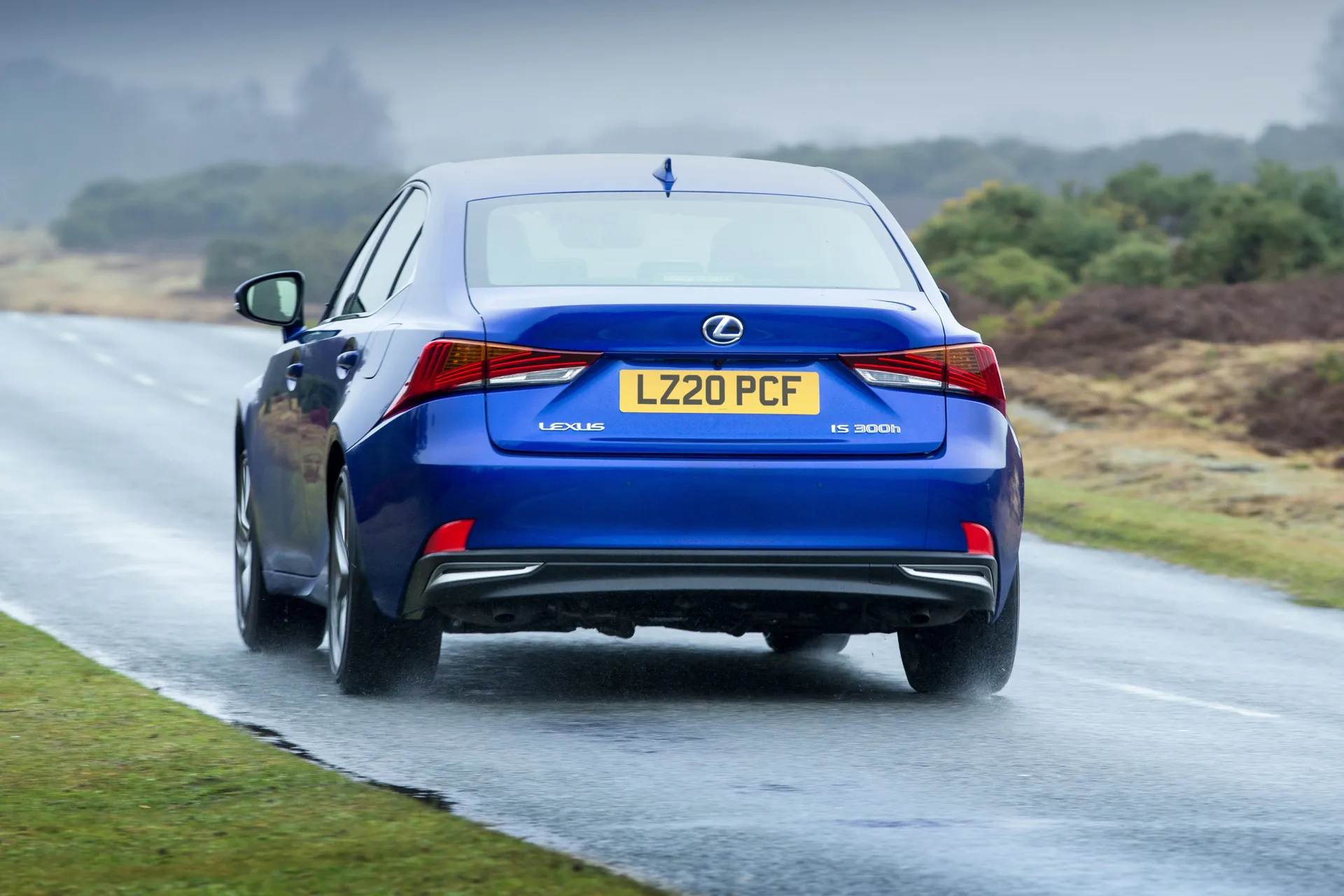
Hybrid models start at about the same price, thanks to the fact they’ve been around for a few years now. With all, there’s a certain expectancy of good reliability, so you should be able to buy older, higher mileage cars with a degree of confidence.
Trim levels and standard equipment
The Lexus IS offers heated front seats, alloy wheels, Sat Nav, DAB, twin-zone climate control, parking sensors and Lexus Safety System+ containing Dynamic Radar Cruise Control, Pre-Collision System, Lane Keeping Assist and Automatic High Beam Control.
The Lexus IS F-Sport adds sports suspension, driver and passenger eight-way electrically adjustable seats, 18-inch alloy wheels, rain-sensing wipers, auto-dimming rear-view mirror and F-Sport specific styling inside and out.
Ask the heycar experts: common questions
Is the Lexus IS a good car?
What does Lexus IS stand for?
Is the Lexus IS200 a V6?
Get our latest advice, news and offers
Keep me updated by email with the latest advice, news and offers from heycar.
By submitting you agree to our privacy policy



